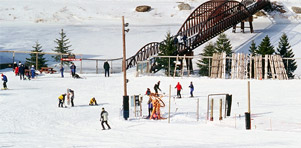Type II Skier (Intermediate)
Moderate skiing at average visual indicator settings
- Prefer a variety of speeds
- Prefer varied terrain
- Type II settings apply to skiers who do not meet all the descriptions of Type I or Type III classifications
Big Sky offers instant access to some of the most diverse skiing and snowboarding amid breathtaking vistas in the Lower 48. Float down a 2,000-vertical-foot, powder-filled bowl beneath Lone Peak; bob and weave through the Bavarian Forest; ride the Lone Peak Tram for a bird’s-eye view of untamed wilderness. You’ll find almost twice as many acres as skiers or riders. Out there, they like their elbow room.
Here is the reason why we go—just read our last blog from Big Sky:
This week has been a whirlwind of powder, sunshine and more powder. Starting on Saturday night and on into Sunday we received upward of 20 inches on the upper mountain and the snow just hasn’t stopped falling. As of Thursday night we have received what I estimate to be close to 4ft in the past five days and more is expected overnight. Is there such a thing as too much snow? Absolutely not, but I can tell you that everyone that has been skiing and riding here for the past week, including myself, has turned into zombies with Jello for legs after tearing through feet after feet of new snow.
Tuesday was an incredible day with good friends, great snow and a little sunshine. The forecast had been calling for only an inch overnight, but Lone Peak got lucky and got about 10 inches. I spent the day on Challenger with skiers Kyle and Chris, along with fellow boarders RC and Cameron. We headed straight for Outer Limits (which was untouched) and then above the Moonlight Cliffs. With RC in position taking photos I went first and boosted a nice sized drop straight into thigh deep snow and immediately tumbled down the run out. Next, Cameron dropped the same cliff that I just ate it on and rode away smooth, making it look much easier then I did. Up next was Chris who without hesitation launched the cliff straight to an epic faceplant. The powder was so deep that Chris was all smiles even after going face first into the snow upon landing a 20ft+ drop.
We stayed over on challenger for the remainder of the day, riding up an empty lift and skiing down empty powder runs. It was a very relaxing powder day as there was no pressure to ski or board something before others got to it simply because there was too much snow and too few skiers. We ended the day with a run down the Pinnacles, which is an absolutely breathtaking run do to the incredible rock formations from top to bottom. I often think of the Pinnacles as a fun run due to the views, but not necessarily for the deepest snow as it sloughs out a lot. But today was different, the snow was deep from the get go as I watched the guys make nearly waist deep turns around upper set of pinnacles. The snow was good enough that I decided to take one of my favorite lines on the mountain, the short but super narrow chute at the bottom skiers left of the Pinnacles. After a sketchy second of commitment the chute opens open into a powder field above Upper Morning Star where you can make some hero turns and comfortably slow yourself down.
Reservations at the Lake Condominiums at Big Sky for seven (7) nights, includes four (4) days of access riding (four-day mountain pass) with our local team.
Big Sky features the best in-bound terrain in North America. Regardless of your level of ability this mountain has more trails, more lifts, more bowls and more glades than anywhere else. The Tram continues to transport technical skiers and riders to some of the most difficult terrain in the country.
Big Sky rises to 11,150 feet and has one of the nation’s largest vertical drops at 4,180 feet and over 3600 acres of ridin’ with less than two people per acre on a bad day. We will be in the heart of the Rocky Mountains where buffalo and elk herds, eagles, and, of course, Yellowstones’ famous geysers are only eighteen miles away.
Make your own travel plans to arrive Monday and catch a Karst Stage coach round-trip for $80.00. It takes ya right to our door.
Travel insurance is available; just head to www.travelsafe.com and hedge your bets.
This trip is priced at one-half our competition. Check it out but do it soon—this trip is limited. See ya ridin’.
A parent or legal guardian must complete and bring along a Minor Permissions Slip for each child age sixteen (16) and under.
Your bindings settings usually follow your batting stance. If you are right-handed and bat right-handed, then you will probably feel most comfortable with your left foot forward (regular). If you are left-handed or bat “lefty,” then you will likely feel right foot forward is more natural (goofy).
These are just guidelines to start. We can help you find the right fit for your ride.

Determining your ski ability is your responsibility!
Your ski ability, height, weight, age, and boot-sole length are used by the shop to determine the visual indicator settings of your ski bindings. Be sure to provide accurate information, as any error may increase your risk of injury. Consult the skier type descriptions to select your classification. These descriptions are compatible with ASTM and ISO documents.
Cautious skiing at lower visual indicator settings
Moderate skiing at average visual indicator settings
Aggressive skiing at higher visual indicator settings